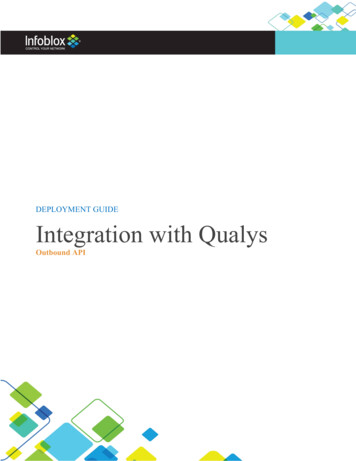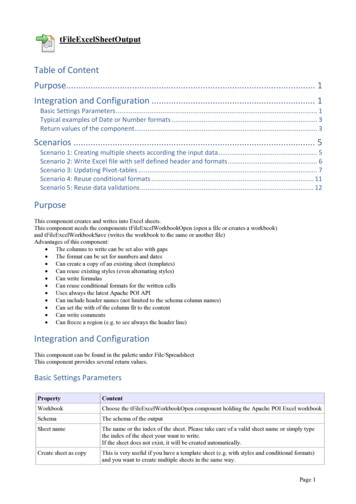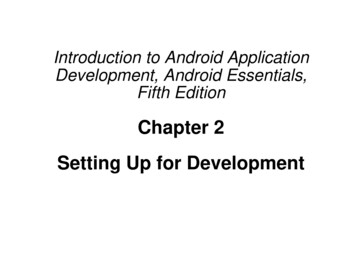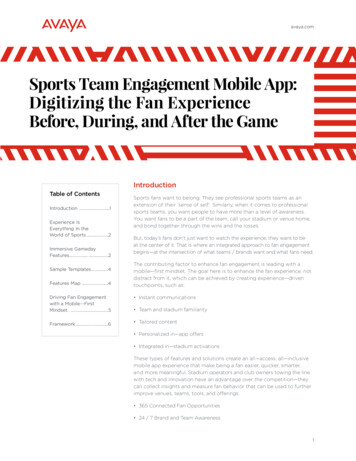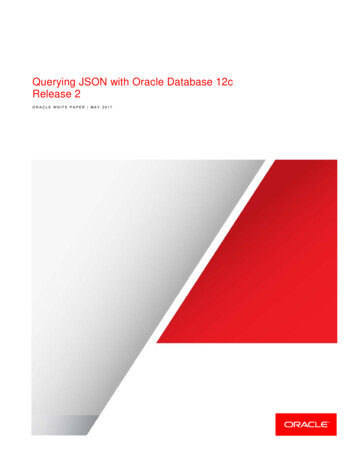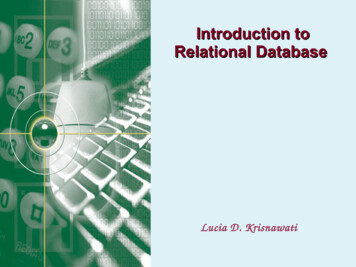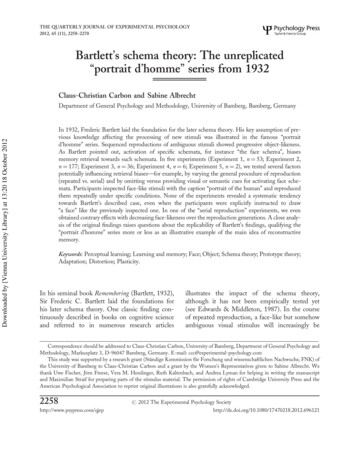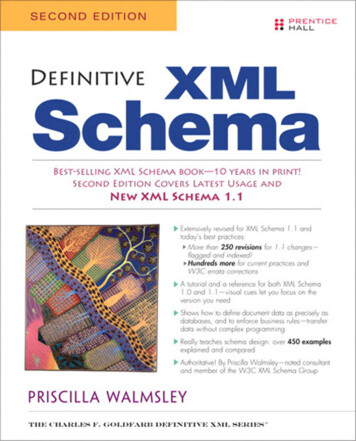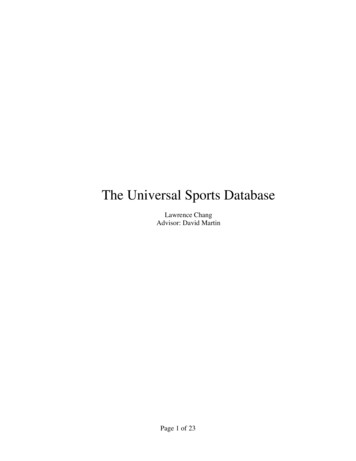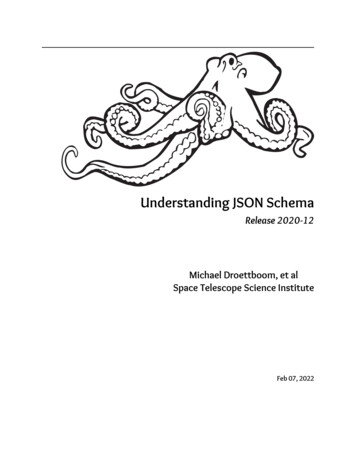
Transcription
Understanding JSON SchemaRelease 2020-12Michael Droettboom, et alSpace Telescope Science InstituteFeb 07, 2022
Contents1Conventions used in this book1.1 Language-specific notes . . . . . . . . . . . . . . . . . . . . . . . . . . . . . . . . . . . . . . . . .1.2 Draft-specific notes . . . . . . . . . . . . . . . . . . . . . . . . . . . . . . . . . . . . . . . . . . . .1.3 Examples . . . . . . . . . . . . . . . . . . . . . . . . . . . . . . . . . . . . . . . . . . . . . . . . .33442What is a schema?73The basics3.1 Hello, World! . . . . . . . .3.2 The type keyword . . . . .3.3 Declaring a JSON Schema .3.4 Declaring a unique identifier4.1111121313JSON Schema Reference4.1 Type-specific keywords . . . .4.2 string . . . . . . . . . . . . . .4.2.1Length . . . . . . . . .4.2.2Regular Expressions .4.2.3Format . . . . . . . . .4.3 Regular Expressions . . . . . .4.3.1Example . . . . . . . .4.4 Numeric types . . . . . . . . .4.4.1integer . . . . . . . . .4.4.2number . . . . . . . .4.4.3Multiples . . . . . . .4.4.4Range . . . . . . . . .4.5 object . . . . . . . . . . . . . .4.5.1Properties . . . . . . .4.5.2Pattern Properties . . .4.5.3Additional Properties .4.5.4Unevaluated Properties4.5.5Required Properties . .4.5.6Property names . . . .4.5.7Size . . . . . . . . . .4.6 array . . . . . . . . . . . . . .4.6.1Items . . . . . . . . .4.6.2Tuple validation . . . i
4.74.84.94.104.114.124.1356Structuring a complex schema5.1 Schema Identification . . . .5.2 Base URI . . . . . . . . . . .5.2.1Retrieval URI . . . .5.2.2 id . . . . . . . . . .5.2.3JSON Pointer . . . .5.2.4 anchor . . . . . . .5.3 ref . . . . . . . . . . . . . .5.4 defs . . . . . . . . . . . . .5.5 Recursion . . . . . . . . . . .5.6 Extending Recursive Schemas5.7 Bundling . . . . . . . . . . .AcknowledgmentsIndexii4.6.3Unevaluated Items . . . . . . . .4.6.4Contains . . . . . . . . . . . . . .4.6.5Length . . . . . . . . . . . . . . .4.6.6Uniqueness . . . . . . . . . . . .boolean . . . . . . . . . . . . . . . . . . .null . . . . . . . . . . . . . . . . . . . . .Generic keywords . . . . . . . . . . . . .4.9.1Annotations . . . . . . . . . . . .4.9.2Comments . . . . . . . . . . . . .4.9.3Enumerated values . . . . . . . .4.9.4Constant values . . . . . . . . . .Media: string-encoding non-JSON data . .4.10.1 contentMediaType . . . . . . . .4.10.2 contentEncoding . . . . . . . . .4.10.3 contentSchema . . . . . . . . . .4.10.4 Examples . . . . . . . . . . . . .Schema Composition . . . . . . . . . . . .4.11.1 allOf . . . . . . . . . . . . . . . .4.11.2 anyOf . . . . . . . . . . . . . . .4.11.3 oneOf . . . . . . . . . . . . . . .4.11.4 not . . . . . . . . . . . . . . . . .4.11.5 Properties of Schema CompositionApplying Subschemas Conditionally . . .4.12.1 dependentRequired . . . . . . . .4.12.2 dependentSchemas . . . . . . . .4.12.3 If-Then-Else . . . . . . . . . . . .4.12.4 Implication . . . . . . . . . . . .Declaring a Dialect . . . . . . . . . . . . .4.13.1 schema . . . . . . . . . . . . . .4.13.2 Vocabularies . . . . . . . . . . . 26368696970.7373747475767677787980808385
Understanding JSON Schema, Release 2020-12JSON Schema is a powerful tool for validating the structure of JSON data. However, learning to use it by reading itsspecification is like learning to drive a car by looking at its blueprints. You don’t need to know how an electric motorfits together if all you want to do is pick up the groceries. This book, therefore, aims to be the friendly driving instructorfor JSON Schema. It’s for those that want to write it and understand it, but maybe aren’t interested in building theirown car—er, writing their own JSON Schema validator—just yet.Note: This book describes JSON Schema draft 2020-12. Earlier versions of JSON Schema are not completelycompatible with the format described here, but for the most part, those differences are noted in the text.Where to begin? This book uses some novel conventions (page 3) for showing schema examples and relating JSON Schema toyour programming language of choice. If you’re not sure what a schema is, check out What is a schema? (page 7). The basics (page 11) chapter should be enough to get you started with understanding the core JSON SchemaReference (page 15). When you start developing large schemas with many nested and repeated sections, check out Structuring acomplex schema (page 73). json-schema.org has a number of resources, including the official specification and tools for working with JSONSchema from various programming languages. There are a number of online JSON Schema tools that allow you to run your own JSON schemas against exampledocuments. These can be very handy if you want to try things out without installing any software.Contents1
Understanding JSON Schema, Release 2020-122Contents
CHAPTER1Conventions used in this book Language-specific notes (page 3) Draft-specific notes (page 4) Examples (page 4)1.1 Language-specific notesThe names of the basic types in JavaScript and JSON can be confusing when coming from another dynamic language.I’m a Python programmer by day, so I’ve notated here when the names for things are different from what they are inPython, and any other Python-specific advice for using JSON and JSON Schema. I’m by no means trying to create aPython bias to this book, but it is what I know, so I’ve started there. In the long run, I hope this book will be usefulto programmers of all stripes, so if you’re interested in translating the Python references into Algol-68 or any otherlanguage you may know, pull requests are welcome!The language-specific sections are shown with tabs for each language. Once you choose a language, that choice will beremembered as you read on from page to page.For example, here’s a language-specific section with advice on using JSON in a few different languages:PythonIn Python, JSON can be read using the json module in the standard library.RubyIn Ruby, JSON can be read using the json gem.3
Understanding JSON Schema, Release 2020-12CFor C, you may want to consider using Jansson to read and write JSON.1.2 Draft-specific notesThe JSON Schema standard has been through a number of revisions or “drafts”. The current version is Draft 2020-12,but some older drafts are still widely used as well.The text is written to encourage the use of Draft 2020-12 and gives priority to the latest conventions and features, butwhere it differs from earlier drafts, those differences are highlighted in special call-outs. If you only wish to target Draft2020-12, you can safely ignore those sections.New in draft 2020-12Draft 2019-09This is where anything pertaining to an old draft would be mentioned.1.3 ExamplesThere are many examples throughout this book, and they all follow the same format. At the beginning of each exampleis a short JSON schema, illustrating a particular principle, followed by short JSON snippets that are either valid orinvalid against that schema. Valid examples are in green, with a checkmark. Invalid examples are in red, with a cross.Often there are comments in between to explain why something is or isn’t valid.Note: These examples are tested automatically whenever the book is built, so hopefully they are not just helpful, butalso correct!For example, here’s a snippet illustrating how to use the number type:{ json schema }{ "type": "number" }!42!-1Simple floating point number:4Chapter 1. Conventions used in this book
Understanding JSON Schema, Release 2020-12!5.0Exponential notation also works:!2.99792458e8Numbers as strings are rejected:%"42"1.3. Examples5
Understanding JSON Schema, Release 2020-126Chapter 1. Conventions used in this book
CHAPTER2What is a schema?If you’ve ever used XML Schema, RelaxNG or ASN.1 you probably already know what a schema is and you canhappily skip along to the next section. If all that sounds like gobbledygook to you, you’ve come to the right place. Todefine what JSON Schema is, we should probably first define what JSON is.JSON stands for “JavaScript Object Notation”, a simple data interchange format. It began as a notation for the worldwide web. Since JavaScript exists in most web browsers, and JSON is based on JavaScript, it’s very easy to supportthere. However, it has proven useful enough and simple enough that it is now used in many other contexts that don’tinvolve web surfing.At its heart, JSON is built on the following data structures: object:{ "key1": "value1", "key2": "value2" } array:[ "first", "second", "third" ] number:423.1415926 string:"This is a string" boolean:truefalse null:7
Understanding JSON Schema, Release 2020-12nullThese types have analogs in most programming languages, though they may go by different names.PythonThe following table maps from the names of JSON types to their analogous types in arraybooleannulldictlistboolNone4545Since JSON strings always support unicode, they are analogous to unicode on Python 2.x and str on Python 3.x.JSON does not have separate types for integer and floating-point.RubyThe following table maps from the names of JSON types to their analogous types in ass66JSON does not have separate types for integer and floating-point.With these simple data types, all kinds of structured data can be represented. With that great flexibility comes greatresponsibility, however, as the same concept could be represented in myriad ways. For example, you could imaginerepresenting information about a person in JSON in different ways:{}{"name": "George Washington","birthday": "February 22, 1732","address": "Mount Vernon, Virginia, United States""first name": "George",(continues on next page)8Chapter 2. What is a schema?
Understanding JSON Schema, Release 2020-12(continued from previous page)}"last name": "Washington","birthday": "1732-02-22","address": {"street address": "3200 Mount Vernon Memorial Highway","city": "Mount Vernon","state": "Virginia","country": "United States"}Both representations are equally valid, though one is clearly more formal than the other. The design of a record willlargely depend on its intended use within the application, so there’s no right or wrong answer here. However, whenan application says “give me a JSON record for a person”, it’s important to know exactly how that record should beorganized. For example, we need to know what fields are expected, and how the values are represented. That’s whereJSON Schema comes in. The following JSON Schema fragment describes how the second example above is structured.Don’t worry too much about the details for now. They are explained in subsequent chapters.{ json schema }{}"type": "object","properties": {"first name": { "type": "string" },"last name": { "type": "string" },"birthday": { "type": "string", "format": "date" },"address": {"type": "object","properties": {"street address": { "type": "string" },"city": { "type": "string" },"state": { "type": "string" },"country": { "type" : "string" }}}}By “validating” the first example against this schema, you can see that it fails:%{}"name": "George Washington","birthday": "February 22, 1732","address": "Mount Vernon, Virginia, United States"However, the second example passes:9
Understanding JSON Schema, Release 2020-12!{}"first name": "George","last name": "Washington","birthday": "1732-02-22","address": {"street address": "3200 Mount Vernon Memorial Highway","city": "Mount Vernon","state": "Virginia","country": "United States"}You may have noticed that the JSON Schema itself is written in JSON. It is data itself, not a computer program. It’s justa declarative format for “describing the structure of other data”. This is both its strength and its weakness (which itshares with other similar schema languages). It is easy to concisely describe the surface structure of data, and automatevalidating data against it. However, since a JSON Schema can’t contain arbitrary code, there are certain constraintson the relationships between data elements that can’t be expressed. Any “validation tool” for a sufficiently complexdata format, therefore, will likely have two phases of validation: one at the schema (or structural) level, and one atthe semantic level. The latter check will likely need to be implemented using a more general-purpose programminglanguage.10Chapter 2. What is a schema?
CHAPTER3The basics Hello, World! (page 11) The type keyword (page 12) Declaring a JSON Schema (page 13) Declaring a unique identifier (page 13)In What is a schema? (page 7), we described what a schema is, and hopefully justified the need for schema languages.Here, we proceed to write a simple JSON Schema.3.1 Hello, World!When learning any new language, it’s often helpful to start with the simplest thing possible. In JSON Schema, an emptyobject is a completely valid schema that will accept any valid JSON.{ json schema }{ }This accepts anything, as long as it’s valid JSON!4211
Understanding JSON Schema, Release 2020-12!"I'm a string"!{ "an": [ "arbitrarily", "nested" ], "data": "structure" }New in draft 6You can also use true in place of the empty object to represent a schema that matches anything, or false for a schemathat matches nothing.{ json schema }trueThis accepts anything, as long as it’s valid JSON!42!"I'm a string"!{ "an": [ "arbitrarily", "nested" ], "data": "structure" }{ json schema }false%"Resistance is futile.This will always fail!!!"3.2 The type keywordOf course, we wouldn’t be using JSON Schema if we wanted to just accept any JSON document. The most commonthing to do in a JSON Schema is to restrict to a specific type. The type keyword is used for that.12Chapter 3. The basics
Understanding JSON Schema, Release 2020-12Note: When this book refers to JSON Schema “keywords”, it means the “key” part of the key/value pair in an object.Most of the work of writing a JSON Schema involves mapping a special “keyword” to a value within an object.For example, in the following, only strings are accepted:{ json schema }{ "type": "string" }!"I'm a string"%42The type keyword is described in more detail in Type-specific keywords (page 15).3.3 Declaring a JSON SchemaIt’s not always easy to tell which draft a JSON Schema is using. You can use the schema keyword to declare whichversion of the JSON Schema specification the schema is written to. See schema (page 69) for more information. It’sgenerally good practice to include it, though it is not required.Note: For brevity, the schema keyword isn’t included in most of the examples in this book, but it should always beused in the real world.{ json schema }{ " schema": "https://json-schema.org/draft/2020-12/schema" }Draft 4In Draft 4, a schema value of http://json-schema.org/schema# referred to the latest version of JSONSchema. This usage has since been deprecated and the use of specific version URIs is required.3.4 Declaring a unique identifierIt is also best practice to include an id property as a unique identifier for each schema. For now, just set it to a URL ata domain you control, for example:3.3. Declaring a JSON Schema13
Understanding JSON Schema, Release 2020-12{ " id": "http://yourdomain.com/schemas/myschema.json" }The details of id (page 75) become more apparent when you start Structuring a complex schema (page 73).New in draft 6Draft 4In Draft 4, id is just id (without the dollar-sign).14Chapter 3. The basics
CHAPTER4JSON Schema Reference4.1 Type-specific keywordsThe type keyword is fundamental to JSON Schema. It specifies the data type for a schema.At its core, JSON Schema defines the following basic types: string (page 17) number (page 25) integer (page 24) object (page 29) array (page 41) boolean (page 49) null (page 50)These types have analogs in most programming languages, though they may go by different names.15
Understanding JSON Schema, Release 2020-12PythonThe following table maps from the names of JSON types to their analogous types in arraybooleannulldictlistboolNone4545Since JSON strings always support unicode, they are analogous to unicode on Python 2.x and str on Python 3.x.JSON does not have separate types for integer and floating-point.RubyThe following table maps from the names of JSON types to their analogous types in ass66JSON does not have separate types for integer and floating-point.The type keyword may either be a string or an array: If it’s a string, it is the name of one of the basic types above. If it is an array, it must be an array of strings, where each string is the name of one of the basic types, and eachelement is unique. In this case, the JSON snippet is valid if it matches any of the given types.Here is a simple example of using the type keyword:{ json schema }{ "type": "number" }!4216Chapter 4. JSON Schema Reference
Understanding JSON Schema, Release 2020-12!42.0This is not a number, it is a string containing a number.%"42"In the following example, we accept strings and numbers, but not structured data types:{ json schema }{ "type": ["number", "string"] }!42!"Life, the universe, and everything"%["Life", "the universe", "and everything"]For each of these types, there are keywords that only apply to those types. For example, numeric types have a way ofspecifying a numeric range, that would not be applicable to other types. In this reference, these validation keywords aredescribed along with each of their corresponding types in the following chapters.4.2 string Length (page 19) Regular Expressions (page 19) Format (page 20)– Built-in formats (page 21)* Dates and times (page 21)* Email addresses (page 21)* Hostnames (page 21)4.2. string17
Understanding JSON Schema, Release 2020-12* IP Addresses (page 21)* Resource identifiers (page 21)* URI template (page 22)* JSON Pointer (page 22)* Regular Expressions (page 22)The string type is used for strings of text. It may contain Unicode characters.PythonIn Python, "string" is analogous to the unicode type on Python 2.x, and the str type on Python 3.x.RubyIn Ruby, "string" is analogous to the String type.{ json schema }{ "type": "string" }!"This is a string"Unicode characters:!"Déjà vu"!""!"42"%4218Chapter 4. JSON Schema Reference
Understanding JSON Schema, Release 2020-124.2.1 LengthThe length of a string can be constrained using the minLength and maxLength keywords. For both keywords, the valuemust be a non-negative number.{ json schema }{}"type": "string","minLength": 2,"maxLength": 3%"A"!"AB"!"ABC"%"ABCD"4.2.2 Regular ExpressionsThe pattern keyword is used to restrict a string to a particular regular expression. The regular expression syntax is theone defined in JavaScript (ECMA 262 specifically) with Unicode support. See Regular Expressions (page 22) for moreinformation.Note: When defining the regular expressions, it’s important to note that the string is considered valid if the expressionmatches anywhere within the string. For example, the regular expression "p" will match any string with a p in it, suchas "apple" not just a string that is simply "p". Therefore, it is usually less confusing, as a matter of course, to surroundthe regular expression in . , for example, " p ", unless there is a good reason not to do so.The following example matches a simple North American telephone number with an optional area code:4.2. string19
Understanding JSON Schema, Release 2020-12{ json schema }{}"type": "string","pattern": " (\\([0-9]{3}\\))?[0-9]{3}-[0-9]{4} "!"555-1212"!"(888)555-1212"%"(888)555-1212 ext. 532"%"(800)FLOWERS"4.2.3 FormatThe format keyword allows for basic semantic identification of certain kinds of string values that are commonly used.For example, because JSON doesn’t have a “DateTime” type, dates need to be encoded as strings. format allows theschema author to indicate that the string value should be interpreted as a date. By default, format is just an annotationand does not effect validation.Optionally, validator implementations can provide a configuration option to enable format to function as an assertionrather than just an annotation. That means that validation will fail if, for example, a value with a date format isn’t in aform that can be parsed as a date. This can allow values to be constrained beyond what the other tools in JSON Schema,including Regular Expressions (page 22) can do.Note: Implementations may provide validation for only a subset of the built-in formats or do partial validation for agiven format. For example, some implementations may consider a string an email if it contains a @, while others mightdo additional checks for other aspects of a well formed email address.Draft 4-7In Draft 4-7, there is no guarantee that you get annotation-only behavior by default.There is a bias toward networking-related formats in the JSON Schema specification, most likely due to its heritage inweb technologies. However, custom formats may also be used, as long as the parties exchanging the JSON documentsalso exchange information about the custom format types. A JSON Schema validator will ignore any format type that itdoes not understand.20Chapter 4. JSON Schema Reference
Understanding JSON Schema, Release 2020-12Built-in formatsThe following is the list of formats specified in the JSON Schema specification.Dates and timesDates and times are represented in RFC 3339, section 5.6. This is a subset of the date format also commonly known asISO8601 format. "date-time": Date and time together, for example, 2018-11-13T20:20:39 00:00. "time": New in draft 7 Time, for example, 20:20:39 00:00 "date": New in draft 7 Date, for example, 2018-11-13. "duration": New in draft 2019-09 A duration as defined by the ISO 8601 ABNF for “duration”. For example,P3D expresses a duration of 3 days.Email addresses "email": Internet email address, see RFC 5321, section 4.1.2. "idn-email": New in draft 7 The internationalized form of an Internet email address, see RFC 6531.Hostnames "hostname": Internet host name, see RFC 1123, section 2.1. "idn-hostname": New in draft 7 An internationalized Internet host name, see RFC5890, section 2.3.2.3.IP Addresses "ipv4": IPv4 address, according to dotted-quad ABNF syntax as defined in RFC 2673, section 3.2. "ipv6": IPv6 address, as defined in RFC 2373, section 2.2.Resource identifiers "uuid": New in draft 2019-09 A Universally Unique Identifier as defined by RFC 4122.3e4666bf-d5e5-4aa7-b8ce-cefe41c7568aExample: "uri": A universal resource identifier (URI), according to RFC3986. "uri-reference": New in draft 6 A URI Reference (either a URI or a relative-reference), according to RFC3986,section 4.1. "iri": New in draft 7 The internationalized equivalent of a “uri”, according to RFC3987. "iri-reference": New in draft 7 The internationalized equivalent of a “uri-reference”, according to RFC3987If the values in the schema have the ability to be relative to a particular source path (such as a link from a webpage), it isgenerally better practice to use "uri-reference" (or "iri-reference") rather than "uri" (or "iri"). "uri" shouldonly be used when the path must be absolute.4.2. string21
Understanding JSON Schema, Release 2020-12Draft 4Draft 4 only includes "uri", not "uri-reference". Therefore, there is some ambiguity around whether "uri"should accept relative paths.URI template "uri-template": New in draft 6 A URI Template (of any level) according to RFC6570. If you don’t alreadyknow what a URI Template is, you probably don’t need this value.JSON Pointer "json-pointer": New in draft 6 A JSON Pointer, according to RFC6901. There is more discussion on the useof JSON Pointer within JSON Schema in Structuring a complex schema (page 73). Note that this should be usedonly when the entire string contains only JSON Pointer content, e.g. /foo/bar. JSON Pointer URI fragments,e.g. #/foo/bar/ should use "uri-reference". "relative-json-pointer": New in draft 7 A relative JSON pointer.Regular Expressions "regex": New in draft 7 A regular expression, which should be valid according to the ECMA 262 dialect.Be careful, in practice, JSON schema validators are only required to accept the safe subset of Regular Expressions(page 22) described elsewhere in this document.4.3 Regular Expressions Example (page 23)The pattern (page 19) and Pattern Properties (page 31) keywords use regular expressions to express constraints. Theregular expression syntax used is from JavaScript (ECMA 262, specifically). However, that complete syntax is notwidely supported, therefore it is recommended that you stick to the subset of that syntax described below. A single unicode character (other than the special characters below) matches itself. .: Matches any character except line break characters. (Be aware that what constitutes a line break character issomewhat dependent on your platform and language environment, but in practice this rarely matters). : Matches only at the beginning of the string. : Matches only at the end of the string. (.): Group a series of regular expressions into a single regular expression. : Matches either the regular expression preceding or following the symbol. [abc]: Matches any of the characters inside the square brackets. [a-z]: Matches the range of characters. [ abc]: Matches any character not listed.22Chapter 4. JSON Schema Reference
Understanding JSON Schema, Release 2020-12 [ a-z]: Matches any character outside of the range. : Matches one or more repetitions of the preceding regular expression. *: Matches zero or more repetitions of the preceding regular expression. ?: Matches zero or one repetitions of the preceding regular expression. ?, *?, ?: The *, , and ? qualifiers are all greedy; they match as much text as possible. Sometimes this behaviorisn’t desired and you want to match as few characters as possible. (?!x), (? x): Negative and positive lookahead. {x}: Match exactly x occurrences of the preceding regular expression. {x,y}: Match at least x and at most y occurrences of the preceding regular expression. {x,}: Match x occurrences or more of the preceding regular expression. {x}?, {x,y}?, {x,}?: Lazy versions of the above expressions.4.3.1 ExampleThe following example matches a simple North American telephone number with an optional area code:{ json schema }{}"type": "string","pattern": " (\\([0-9]{3}\\))?[0-9]{3}-[0-9]{4} "!"555-1212"!"(888)555-1212"%"(888)555-1212 ext. 532"%"(800)FLOWERS"4.4 Numeric types4.4. Numeric types23
Understanding JSON Schema, Release 2020-12 integer (page 24) number (page 25) Multiples (page 26) Range (page 26)There are two numeric types in JSON Schema: integer (page 24) and number (page 25). They share the same validationkeywords.Note: JSON has no standard way to represent complex numbers, so there is no way to test for them in JSON Schema.4.4.1 integerThe integer type is used for integral numbers. JSON does not have distinct types for integers and floating-point values.Therefore, the presence or absence of a decimal point is not enough to distinguish between integers and non-integers.For example, 1 and 1.0 are two ways to represent the same value in JSON. JSON Schema considers that value aninteger no matter which representation was used.PythonIn Python, "integer" is analogous to the int type.RubyIn Ruby, "integer" is analogous to the Integer type.{ json schema }{ "type": "int
Understanding JSON Schema, Release 2020-12 C For C, you may want to consider usingJanssonto read and write JSON. 1.2Draft-specific notes The JSON Schema sta
